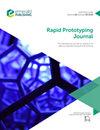AltPrint: new filling and slicing process planning based on deposited material with geometry variation
IF 3.6
4区 工程技术
Q1 ENGINEERING, MECHANICAL
引用次数: 0
Abstract
Purpose This paper aims to address the development and implementation of “AltPrint,” a slicing algorithm based on a new filling process planning from a variation in the deposited material geometry. AltPrint enables changes in the extruded material flow toward local variations in stiffness. The technical feasibility evaluation was conducted experimentally by fused filament fabrication (FFF) process of snap-fit subjected to a mechanical cyclical test. Design/methodology/approach The methodology is based on the estimation of the parameter E from the mathematical relationships among the variation of the material in the material flow, nozzle geometry and extrusion parameters. Calibration, validation and analysis of the printed specimens were divided into two moments, of which the first refers to the material responses (flexural and dynamic mechanical analysis) and the second involves the analysis of the printed components with localized flow properties (for estimating the response to cyclic loading). Finite element analysis assisted in the comparison of two snap-fit geometries, one traditional and one generated by AltPrint. Finally, three examples of compliant mechanisms were developed to demonstrate the potential of the algorithm in the generation of functional prototypes. Findings The contribution of AltPrint is the variable fill width integrated with the slicing software that varies the print parameters in different regions of the object. The alternative extrusion method based on material rate variation was conceived as an “open software” available in GitHub platform, hence, open manufacturing with initial focus on desktop 3D printer based on FFF. The slicing method provides deposited variable-width segments in an organized and replicable filling strategy, resulting in mechanical properties variations in specific regions of a part. It was implemented and evaluated experimentally and indicated potential applications in parts manufactured by the additive process based on extrusion, which requires local flexibilities. Originality/value This paper presents a new alternative method for application in an open additive manufacturing context, specifically for additive extrusion techniques that enable local variations in the material flow. Its potential for manufacturing functional parts, which require flexibility due to cyclic loading, was demonstrated by fabrication and experimental evaluations of parts made in acrylonitrile butadiene styrene filament. The changes proposed by AltPrint enable geometric modifications in the response of the printed parts. The proposed slicing and filling control of parameters is inserted in a context of design for additive manufacturing and shows great potential in the area of product design.AltPrint:基于几何形状变化的沉积材料的新填充和切片工艺规划
本文旨在解决“AltPrint”的开发和实现,这是一种基于沉积材料几何形状变化的新填充工艺规划的切片算法。AltPrint能够改变挤压材料流向刚度的局部变化。通过机械循环试验,采用熔丝制造(FFF)工艺进行了技术可行性评价。设计/方法/方法该方法是根据物料在物料流、喷嘴几何形状和挤出参数中的变化之间的数学关系来估计参数E。打印样品的校准、验证和分析分为两个阶段,其中第一个阶段是材料响应(弯曲和动态力学分析),第二个阶段是打印部件局部流动特性的分析(用于估计循环加载的响应)。有限元分析有助于比较两种合扣几何形状,一种是传统的,另一种是由AltPrint生成的。最后,开发了三个柔性机构示例,以展示该算法在生成功能原型方面的潜力。AltPrint的贡献在于可变填充宽度与切片软件相结合,可以改变物体不同区域的打印参数。基于材料速率变化的替代挤出方法被设想为GitHub平台上可用的“开放软件”,因此,开放式制造最初侧重于基于FFF的桌面3D打印机。切片方法在有组织和可复制的填充策略中提供沉积的可变宽度段,从而导致零件特定区域的机械性能变化。实验结果表明,该方法在基于挤压的增材工艺制造零件中具有潜在的应用前景,这需要局部柔性。原创性/价值本文提出了一种新的替代方法,适用于开放的增材制造环境,特别是增材挤压技术,使材料流动的局部变化。丙烯腈-丁二烯-苯乙烯长丝制成的部件的制造和实验评估证明了它在制造功能部件方面的潜力,这些功能部件由于循环加载而需要灵活性。AltPrint提出的改变使打印部件的响应能够进行几何修改。所提出的参数切片和填充控制被插入到增材制造设计的背景下,在产品设计领域显示出巨大的潜力。
本文章由计算机程序翻译,如有差异,请以英文原文为准。
求助全文
约1分钟内获得全文
求助全文
来源期刊

Rapid Prototyping Journal
工程技术-材料科学:综合
CiteScore
8.30
自引率
10.30%
发文量
137
审稿时长
4.6 months
期刊介绍:
Rapid Prototyping Journal concentrates on development in a manufacturing environment but covers applications in other areas, such as medicine and construction. All papers published in this field are scattered over a wide range of international publications, none of which actually specializes in this particular discipline, this journal is a vital resource for anyone involved in additive manufacturing. It draws together important refereed papers on all aspects of AM from distinguished sources all over the world, to give a truly international perspective on this dynamic and exciting area.
-Benchmarking – certification and qualification in AM-
Mass customisation in AM-
Design for AM-
Materials aspects-
Reviews of processes/applications-
CAD and other software aspects-
Enhancement of existing processes-
Integration with design process-
Management implications-
New AM processes-
Novel applications of AM parts-
AM for tooling-
Medical applications-
Reverse engineering in relation to AM-
Additive & Subtractive hybrid manufacturing-
Industrialisation
 求助内容:
求助内容: 应助结果提醒方式:
应助结果提醒方式:


